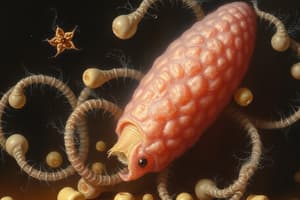Podcast
Questions and Answers
What are the two main classifications of antiamoebic drugs?
What are the two main classifications of antiamoebic drugs?
Tissue amoebicides and luminal amoebicides.
Which drug is primarily used for asymptomatic intestinal amoebiasis?
Which drug is primarily used for asymptomatic intestinal amoebiasis?
Diloxanide furoate.
Name one tissue amoebicide effective against extra-intestinal amoebiasis.
Name one tissue amoebicide effective against extra-intestinal amoebiasis.
Chloroquine.
What is a common side effect of iodoquinol when taken in large doses?
What is a common side effect of iodoquinol when taken in large doses?
List two examples of nitroimidazole drugs used for amoebiasis.
List two examples of nitroimidazole drugs used for amoebiasis.
What type of infections are tissue amoebicides specifically designed to treat?
What type of infections are tissue amoebicides specifically designed to treat?
Which drug is a luminal amoebicide among the mentioned drugs?
Which drug is a luminal amoebicide among the mentioned drugs?
What role do amides play in the treatment of amoebiasis?
What role do amides play in the treatment of amoebiasis?
What adverse effect is associated with chloroquine?
What adverse effect is associated with chloroquine?
What is Quiniodochlor and what type of amoebicide is it?
What is Quiniodochlor and what type of amoebicide is it?
What significant eye defect can be caused by high doses of certain medications?
What significant eye defect can be caused by high doses of certain medications?
Name one nitromidazole antibiotic and its primary use.
Name one nitromidazole antibiotic and its primary use.
What type of amoebicide is Paromomycin and what is its indication?
What type of amoebicide is Paromomycin and what is its indication?
What primary bacteria do nitromidazoles target?
What primary bacteria do nitromidazoles target?
What condition has nitazoxanide been approved to treat in AIDS patients?
What condition has nitazoxanide been approved to treat in AIDS patients?
What is the primary focus of Emetine and dehydroemetine in treatment?
What is the primary focus of Emetine and dehydroemetine in treatment?
What enzyme does Tizoxanide inhibit, and why is it significant for anaerobic organisms?
What enzyme does Tizoxanide inhibit, and why is it significant for anaerobic organisms?
Which infections is Diloxanide furoate primarily used to treat?
Which infections is Diloxanide furoate primarily used to treat?
What are the common side effects associated with some of the mentioned drug treatments?
What are the common side effects associated with some of the mentioned drug treatments?
What makes Tinidazole different from metronidazole?
What makes Tinidazole different from metronidazole?
What type of amoebicides are effective against amoebas in both the intestines and tissues?
What type of amoebicides are effective against amoebas in both the intestines and tissues?
How can alcohol affect the effectiveness and tolerance of certain amoebicides?
How can alcohol affect the effectiveness and tolerance of certain amoebicides?
What type of drug interactions can anticoagulants (Coumarins) have with some of the treatments discussed?
What type of drug interactions can anticoagulants (Coumarins) have with some of the treatments discussed?
What has been reported in comparative trials regarding cure rates in amoebiasis with certain treatments?
What has been reported in comparative trials regarding cure rates in amoebiasis with certain treatments?
What are the two major mechanisms of action of Emetine and Dehydroemetine?
What are the two major mechanisms of action of Emetine and Dehydroemetine?
What is a key characteristic of Luminal Amoebicides?
What is a key characteristic of Luminal Amoebicides?
Which drug is a congener of Metronidazole with similar potency?
Which drug is a congener of Metronidazole with similar potency?
What is the typical half-life of the drugs mentioned for amoebiasis?
What is the typical half-life of the drugs mentioned for amoebiasis?
What side effect was reported with an incidence of 2% when using Metronidazole?
What side effect was reported with an incidence of 2% when using Metronidazole?
Which drug is noted for better tolerability with fewer side effects like nausea or vomiting?
Which drug is noted for better tolerability with fewer side effects like nausea or vomiting?
What types of toxicities are associated with the drugs used in amoebiasis treatment?
What types of toxicities are associated with the drugs used in amoebiasis treatment?
What is the primary use of Emetine and Dehydroemetine in treatment?
What is the primary use of Emetine and Dehydroemetine in treatment?
Flashcards are hidden until you start studying
Study Notes
Antiamoebic Drugs
- Tissue amoebicides target amoebas in tissues outside the intestines (e.g., liver, lungs)
- Luminal amoebicides target amoebas in the intestines
- Both intestinal (luminal) and extra-intestinal amoebicides work against amoebas in both the intestines and tissues
Tissue Amoebicides
- Chloroquine: Treats extra-intestinal amoebiasis only
- Metronidazole, Tinidazole, Secnidazole, Ornidazole: Effective against amoebas in both the intestines and tissues
- Emetine, Dehydroemetine: Effective against amoebas in both the intestines and tissues, but rarely used now due to toxicity
Luminal Amoebicides
- Diloxanide Furoate: Drug of choice for asymptomatic intestinal amoebiasis and carriers. Used with tissue amoebicides for extra-intestinal infections.
- Quiniodochlor: High doses can cause eye defects (Subacute Myelo Optic Neuropathy or SMON)
- Paromomycin: An aminoglycoside, also has some activity against cryptosporidiosis in AIDS patients
- Iodoquinol: Can lead to thyroid enlargement and peripheral neuropathy in large doses
- Tetracycline: An antibiotic
- Nitazoxanide: Treats giardiasis and cryptosporidiosis, inhibits the enzyme pyruvate ferrodoxin oxidoreductase (PFOR), which is essential for energy metabolism in anaerobic organisms.
Metronidazole
- Indications: Treats infections caused by anaerobic bacteria, including:
- Bacteroides spp.
- Clostridium spp.
- Trichomoniasis (vaginal or urethral infection)
- Pseudomembranous colitis (caused by C. difficile)
- Giardiasis (intestinal parasite)
- Side Effects: Nausea, metallic taste in mouth, abdominal cramps
- Drug Interactions:
- Alcohol: can cause a disulfiram-like reaction (nausea, vomiting, flushing)
- Anticoagulants (Coumarins): May increase the anticoagulant effect, potentially leading to bleeding.
Other Important Information
- Tinidazole: Similar to Metronidazole but with a longer duration of action.
- Secnidazole: Congener of Metronidazole with the same spectrum of activity and potency, but easier dosing.
- Satranidazole: Better tolerated than Metronidazole.
- Emetine and Dehydroemetine: Inhibit protein synthesis and can be used parenterally in severe hepatic amoebiasis.
- Paromomycin: Has some activity against cryptosporidiosis in AIDS patients.
- Nitazoxanide: A prodrug converted to tizoxanide, exhibits good activity against Cryptosporidium parvum.
Studying That Suits You
Use AI to generate personalized quizzes and flashcards to suit your learning preferences.


